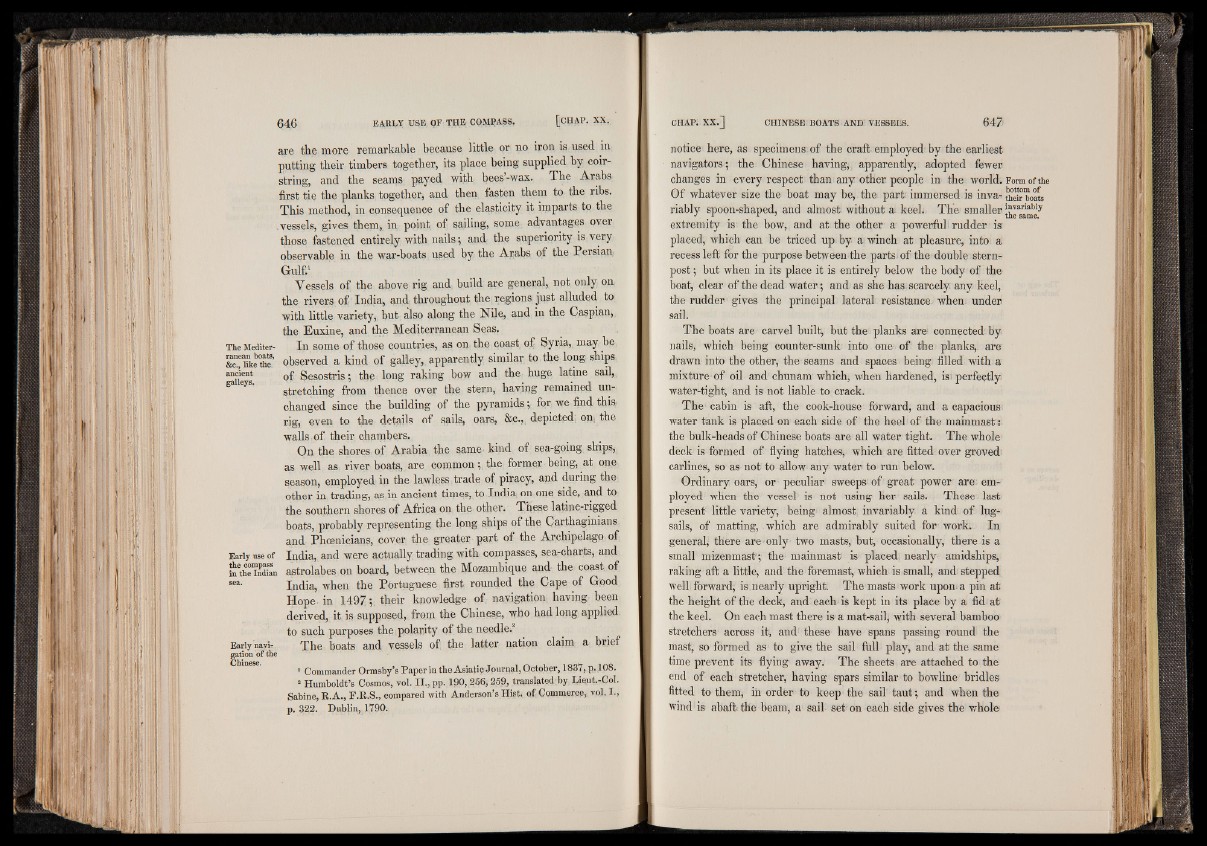
are the more remarkable because little or h o iron is used in
putting their timbers together, its place being supplied by coir-
string, and the seams payed with: bees’-wax. The Arabs
first tie the planks together, and then fasten them to the ribs.
This method, in consequence of the elasticity it imparts to the
vessels, gives them, in point of sailing, some advantages over
those fastened entirely with nails; and the superiority is very
observable in the war-boats used by the Arabs of the Persian:
Gulfi1
Vessels of the above rig and build are general, not only on
the rivers of India, and throughout the regions just alluded to,
with little variety, but also along the Nile, and in the Caspian,
the Euxine, and the Mediterranean Seas.
The Mediter- In some of those countries, as on the coast of Syria, may be
&c^ilkethe' observed a kind of galley,.apparently similar to the long ships
of Sesostris; the long raking bow and the huge latine sail,,
stretching from thence over the stern, having remained unchanged
since the building of the pyramids ;: for we find this
rig, even to the: details of sails, oars, &c., depicted: oui the
walls of their chambers.
On the shores, of Arabia the same, kind of sea-going ships,
as well as river boats, are common the former being, at one
season, employed in the lawless trade of piracy, and during the;
other in trading, as.in ancient times, to India, on one side, and to
the southern shores of Africa on, the other. These latine-rigged
boats, probably representing the lpng ships of the Carthaginians
and Phoenicians, cover the greater part of the Archipelago of
Early use of India, and were actually trading with compasses, searcbarts, and
in'the'indian astrolabes on board, between the Mozambique and the coast, of
sea- India, when the Portuguese first rounded the Cape of Good
Hope, in 1497 their knowledge of navigation, having been
derived, it is supposed, from the Chinese, who had long applied
to such purposes the polarity of the needle.2
Early nayi. The boats and vessels of the latter nation claim a brief
gation o f the
1 Commander Ormsby’s Paper in the Asiatic Journal, October, 1837, p. 108.
2 Humboldt’s Cosmos, vol. I I ., pp. 190, 236,259, translated,by Lieut.-Col.
Sabine, R .A., F.R.S., compared with Anderson’s H ist. of. Commerce, vol. I.,
p. 322. Dublin, 1790.
notice here, as specimens of the craft employed by the earliest
navigators; the. Chinese having, apparently, adopted fewer
changes in every respect than any other people in the world. Form of the
Of whatever size the boat may be, the part: immersed is inva- iS™0ats
riably spoon-shaped, and almost without a: keel. The smaller
extremity is the bow,, and at the other a: powerful rudder is
placed, which can be triced up by a, winch at pleasure, into a
recess left for the purpose between the parts of the double stern-
post; but when in its place it is entirely below the body of the
boat, clear of the dead water; and as she has scarcely, any keel,
the rudder-' gives the principal lateral resistance, when, under
sail.T
he boats are carvel built, but the planks are connected: by
nails, which being counter-sunk into one of the planks,, are
drawn into the other, the seams and spaces being, filled with a
mixture of oil and chunam which, when hardened, is; perfectly,
water-tight, and is not liable to crack.
The; cabin is aft, the cook-house forward, and a capacious:
water tank is placed on each side of the heel of the mainmast:
the bulk-heads of Chinese boats are all water tight. The whole
deck is formed of flying hatches, which are fitted over graved:
carlines, so as not to allow any water to run below.
Ordinary oars, or peculiar sweeps of great power are employed
when the vessel is not using her sails. These last
present little variety, being' almost invariably a kind of lug-
sails, of matting, which are admirably suited for work. In
general, there are only two masts, but, occasionally, there is a
small mizenmast; the mainmast is placed nearly amidships,
raking aft a little, and the foremast, which is-small, andstepped
well forward, is.nearly upright; The masts work upon-a pin at
the height of the deck, and each- is kept in its place by a fid: at
the keel. On each mast there is a mat-sail; with several bamboo
stretchers across it1, and these have spans passing round the
mast, so formed as to give the sail fhll play, and at the same
time prevent its flying away. The sheets are attached to the
end of each stretcher, having spars similar to bowline bridles
fitted to them, in order to keep the sail taut; and when the
wind is abaft; the beam, a sail set1 on each side gives the whole